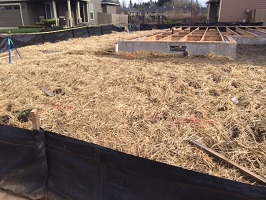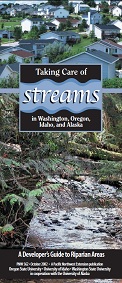tag
Phasing of Construction
Development projects shall be phased where feasible in order to prevent soil erosion and, to the maximum extent practicable, the transport of sediment from the site during construction. Revegetation of exposed areas and maintenance of that vegetation shall be an integral part of the clearing activities for any phase.
Clearing and grading activities for developments shall be permitted only if conducted pursuant to an approved site development plan (e.g., subdivision approval) that establishes permitted areas of clearing, grading, cutting, and filling. When establishing these permitted clearing and grading areas, consideration should be given to minimizing removal of existing trees and minimizing disturbance/compaction of native soils except as needed for building purposes. These permitted clearing and grading areas and any other 3-14 Volume II – Construction Stormwater Pollution Prevention February 2005 areas required to preserve critical or sensitive areas, buffers, native growth protection easements, or tree retention areas as may be required by local jurisdictions, shall be delineated on the site plans and the development site.
Seasonal Work Limitations
From October 1 through April 30, clearing, grading, and other soil disturbing activities shall only be permitted if shown to the satisfaction of the local permitting authority that silt-laden runoff will be prevented from leaving the site through a combination of the following:
A. Site conditions including existing vegetative coverage, slope, soil type, and proximity to receiving waters; and
B. Limitations on activities and the extent of disturbed areas; and
C. Proposed erosion and sediment control measures.
- Based on the information provided and/or local weather conditions, the local permitting authority may expand or restrict the seasonal limitation on site disturbance. The local permitting authority shall take enforcement action - such as a notice of violation, administrative order, penalty, or stop-work order under the following circumstances:
− If, during the course of any construction activity or soil disturbance during the seasonal limitation period, sediment leaves the construction site causing a violation of the surface water quality standard; or
− If clearing and grading limits or erosion and sediment control measures shown in the approved plan are not maintained. The following activities are exempt from the seasonal clearing and grading limitations:
A. Routine maintenance and necessary repair of erosion and sediment control BMPs;
B. Routine maintenance of public facilities or existing utility structures that do not expose the soil or result in the removal of the vegetative cover to soil; and
C. Activities where there is one hundred percent infiltration of surface water runoff within the site in approved and installed erosion and sediment control facilities.
Coordination with Utilities and Other Contractors
The primary project proponent shall evaluate, with input from utilities and other contractors, the stormwater management requirements for February 2005 Volume II – Construction Stormwater Pollution Prevention 3-15 the entire project, including the utilities, when preparing the Construction SWPPP.
Inspection and Monitoring
All BMPs shall be inspected, maintained, and repaired as needed to assure continued performance of their intended function. Site inspections shall be conducted a person who is knowledgeable in the principles and practices of erosion and sediment control. The person must have the skills to 1) assess the site conditions and construction activities that could impact the quality of stormwater, and 2) assess the effectiveness of erosion and sediment control measures used to control the quality of stormwater discharges.
For construction sites one acre or larger that discharge stormwater to surface waters of the state, a Certified Erosion and Sediment Control Specialist shall be identified in the Construction SWPPP and shall be on-site or on-call at all times. Certification may be obtained through an approved training program that meets the erosion and sediment control training standards established by Ecology. Whenever inspection and/or monitoring reveals that the BMPs identified in the Construction SWPPP are inadequate, due to the actual discharge of or potential to discharge a significant amount of any pollutant, appropriate BMPs or design changes shall be implemented as soon as possible.
Maintaining an Updated Construction SWPPP
The Construction SWPPP shall be retained on-site or within reasonable access to the site. The SWPPP shall be modified whenever there is a change in the design, construction, operation, or maintenance at the construction site that has, or could have, a significant effect on the discharge of pollutants to waters of the state. The SWPPP shall be modified if, during inspections or investigations conducted by the owner/operator, or the applicable local or state regulatory authority, it is determined that the SWPPP is ineffective in eliminating or significantly minimizing pollutants in stormwater discharges from the site. The SWPPP shall be modified as necessary to include additional or modified BMPs designed to correct problems identified. Revisions to the SWPPP shall be completed within seven (7) days following the inspection.

